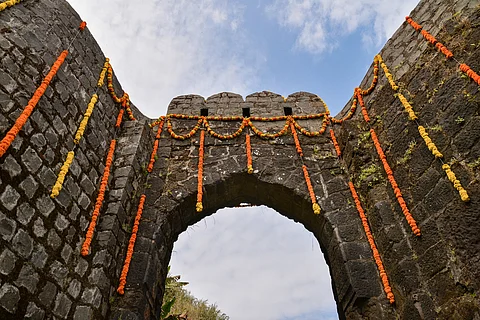
- Destinations
- Experiences
- Stay
- What's new
- Celebrating People
- Responsible Tourism
- CampaignsCampaigns
- Subscribe
- Buy Now

It’s monsoon season in Maharashtra, which means now is the right time to embark on a range of treks to the nearly 350 forts that are littered across the state. In fact, over 15,000 tourists to Sinhagad Fort did just that this past weekend.
The 2,000-year-old structure, which has witnessed epic battles in its heyday, saw a surge in visitor numbers and a collection of INR 2,16,700 from “activity fees” paid to the Ghera Sinhagad Forest Conservation Committee. Families with children made the most of the last vacation day before schools re-opened to take in the fort’s timeless charms and verdant surroundings.
Why is Sinhagad Fort so popular and what makes it special? Outlook Traveller looks into the fort's history and what you can expect from a monsoon holiday there.
Perched on an isolated cliff atop the Sahyadri hills southwest of Pune, Sinhagad Fort is a sentinel of Maharashtra’s glorious past. It was initially known as “Kondhana” after the sage Kaundinya, a disciple of Gautama Buddha.
The site’s strategic location was no mistake—the mountain ranges here provide natural protection owing to the steep slopes. Its claim to fame was the 1670 Battle of Sinhagad, when Maratha ruler Chhatrapati Shivaji Maharaj orchestrated a daring mission to reclaim the fort from the Mughals.
The battle was led by the fearless Tanaji Malusare, who, along with his brave warriors, scaled the steep cliffs under the cover of darkness. After putting up a fierce fight, Malusare succumbed to his injuries. When Shivaji Maharaj heard of his commander’s sacrifice, he famously remarked, “Gad ala, pan Sinha gela” (“The fort is won, but the lion is lost”). In honour of his valiant warrior, “Kondhana” was renamed Sinhagad, which means “Lion’s Fort.”
Sinhagad Fort stands as a testament to strategic military planning and architectural brilliance. Its imposing fortifications and bastions provide commanding views of the Sahyadri mountain range, reinforcing its role as a formidable defence stronghold.
The fort features two main entrances—the Pune Darwaza, facing Pune, and the Kalyan Darwaza, which opens towards the Konkan region. Both showcase intricate stonework and are strategically placed for enhanced security.
One of the most remarkable aspects of the fort is its advanced water storage system, which includes ancient rainwater harvesting techniques and natural reservoirs that ensured a continuous water supply for its inhabitants. The remnants of military barracks and storehouses within the fort offer a glimpse into its storied past, where warriors once lived and prepared for battles.
The fort also houses a memorial to Tanaji Malusare and the tomb of Rajaram I. A brewery and temples dedicated to the Hindu deity Kali and Kaundinya Eshwar are also located at the site. In juxtaposition with modernity, there is also a television tower set up in 1973 that is used to broadcast Doordarshan to Pune residents.
Trek: Sinhagad Fort is a paradise for trekking enthusiasts and food lovers. The two main trekking routes offer varied experiences, with the Sinhagad village route providing a moderately challenging 2.7 km trek that takes around 1.5–two hours, while the Kalyan Darwaza route presents a steeper and more adventurous climb, rewarding trekkers with breathtaking panoramic views.
Exploring the fort: Whether joining a guided tour or exploring independently, every corner of the fort narrates tales of its glorious past. From the heroic legacy of Tanaji Malusare to the historic significance of Lokmanya Tilak’s bungalow, the fort resonates with the echoes of history. The cool mountain air, rugged stone walls and sweeping views of the Sahyadri range will make your trip one to remember.
Snacking on local delights: No trip to Sinhagad is complete without indulging in its famous local delicacies. The small roadside eateries, or tapris, serve up authentic Maharashtrian delights. Pithla bhakri and zunka bhakar provide a wholesome, traditional meal, while crispy kanda bhaji (onion fritters) make for the perfect monsoon treat. A glass of chilled taak (buttermilk) refreshes weary trekkers.
Sinhagad Fort offers a different charm in every season, making it a great place to visit year-round. The best time to go depends on the experience you seek.
Winter is the ideal season to explore the fort. From October to February, the climate remains cool and pleasant. The skies are clear, making it perfect for trekking and photography.
The fort is open throughout the year from 5 AM to 6 PM. If you are trekking to the fort, then there is no entrance fee. However, there is an additional fee for the entry of private vehicles.
Visit the Khadakwasla Dam (16 km away) for a peaceful time, thanks to its calm waters and breathtaking sunset views.
Another reservoir near Sinhagad Fort is Panshet Dam (30 km away). This is a paradise for water sports enthusiasts, who can boat, kayak and Jet Ski in serene waters.
Rajgad Fort is 30 km from Sinhagad. Once the first capital of the Maratha Empire, this fort stands as a proud reminder of the kingdom. The trek to its summit is challenging yet rewarding, offering spectacular views and deep insights into the region’s glorious past.
If you’re looking for a relaxing getaway, Lavasa (59 km away) is a perfect choice. This picturesque hill town, inspired by European architecture, is nestled around a scenic lake. The peaceful atmosphere, charming streets and waterfront promenades make it a great spot to slow down and soak in nature.
The closest city to Sinhagad Fort is Pune, 40 km away.
